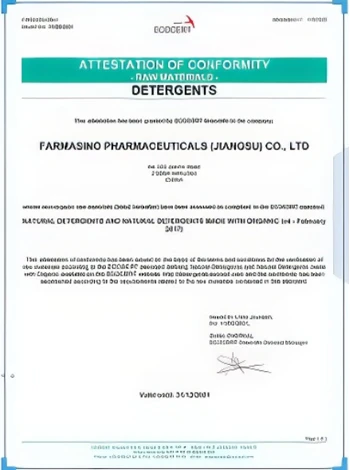



sodium hydroxide from salt water
The Production of Sodium Hydroxide from Salt Water
Sodium hydroxide (NaOH), commonly known as caustic soda, is one of the most important industrial chemicals used in various applications, including the manufacture of paper, textiles, and detergents. It is also employed in water treatment, food preparation, and chemical synthesis. One of the most effective and sustainable methods to produce sodium hydroxide is through the electrolysis of salt water, a process that not only harnesses abundant natural resources but also minimizes the environmental impact of chemical production.
Understanding the Chemistry
The process of making sodium hydroxide from salt water begins with seawater or brine, a concentrated solution of salt (primarily sodium chloride, NaCl). When this salt water is subjected to electrolysis, an electric current is passed through the solution, which leads to the dissociation of sodium ions (Na⁺) and chloride ions (Cl⁻). The electrolysis process can be simplified into three main reactions occurring at the electrodes
1. Anode Reaction At the anode, chloride ions are oxidized to form chlorine gas (Cl₂). \[ 2Cl^- \rightarrow Cl_2(g) + 2e^- \]
2. Cathode Reaction At the cathode, water is reduced to produce hydrogen gas (H₂) and hydroxide ions (OH⁻). \[ 2H_2O + 2e^- \rightarrow H_2(g) + 2OH^- \]
3. Overall Reaction The hydroxide ions generated at the cathode react with the sodium ions in the solution to form sodium hydroxide. \[ Na^+ + OH^- \rightarrow NaOH \]
Thus, the electrolysis of salt water yields sodium hydroxide, chlorine gas, and hydrogen gas
. The simultaneous production of these key industrial gases makes this process particularly valuable.Industrial Applications
sodium hydroxide from salt water

The sodium hydroxide obtained from this method is used widely across many industries. In the chemical industry, it serves as a fundamental building block for the manufacture of various compounds such as soap, synthetic rubber, and pharmaceuticals. In the food industry, caustic soda is used for food processing, such as in the curing of olives and the production of German pretzels, where it gives the characteristic dark color and chewy texture.
The pulp and paper industry also heavily relies on sodium hydroxide for pulp bleaching and the removal of lignin from wood. Furthermore, in water treatment, sodium hydroxide is used to adjust pH levels and neutralize acidic waters, ensuring safe and clean drinking water.
Environmental Considerations
The electrolysis of salt water presents several environmental advantages compared to traditional methods of producing sodium hydroxide, such as the chlor-alkali process, which can release harmful byproducts. By using salt water, a sustainable and plentiful resource, the process minimizes reliance on other raw materials and reduces waste production.
Moreover, the production of chlorine and hydrogen alongside sodium hydroxide can be optimized for further industrial use. Hydrogen, for instance, is increasingly being recognized as a clean fuel source, and its production through electrolysis of seawater supports the development of hydrogen economy initiatives aimed at reducing carbon emissions and combatting climate change.
Challenges and Innovations
Despite its advantages, the process is not without challenges. Effective separation of chlorine gas from the brine solution is crucial to prevent contamination of the sodium hydroxide, as the presence of chlorine is undesirable for many applications. Innovations in membrane technology and electrode design continue to improve the efficiency and safety of this electrolysis process.
In conclusion, the production of sodium hydroxide from salt water through electrolysis offers a compelling combination of sustainability, efficiency, and economic viability. As industries increasingly seek greener solutions, this method not only stands out for its low environmental impact but also supports the circular economy by utilizing available resources. With ongoing technological advancements, we can expect to see further growth in the use of salt water electrolysis as a primary method for producing sodium hydroxide and its associated products in a responsible and sustainable manner.
-
Why Sodium Persulfate Is Everywhere NowNewsJul.07,2025
-
Why Polyacrylamide Is in High DemandNewsJul.07,2025
-
Understanding Paint Chemicals and Their ApplicationsNewsJul.07,2025
-
Smart Use Of Mining ChemicalsNewsJul.07,2025
-
Practical Uses of Potassium MonopersulfateNewsJul.07,2025
-
Agrochemicals In Real FarmingNewsJul.07,2025
-
Sodium Chlorite Hot UsesNewsJul.01,2025










